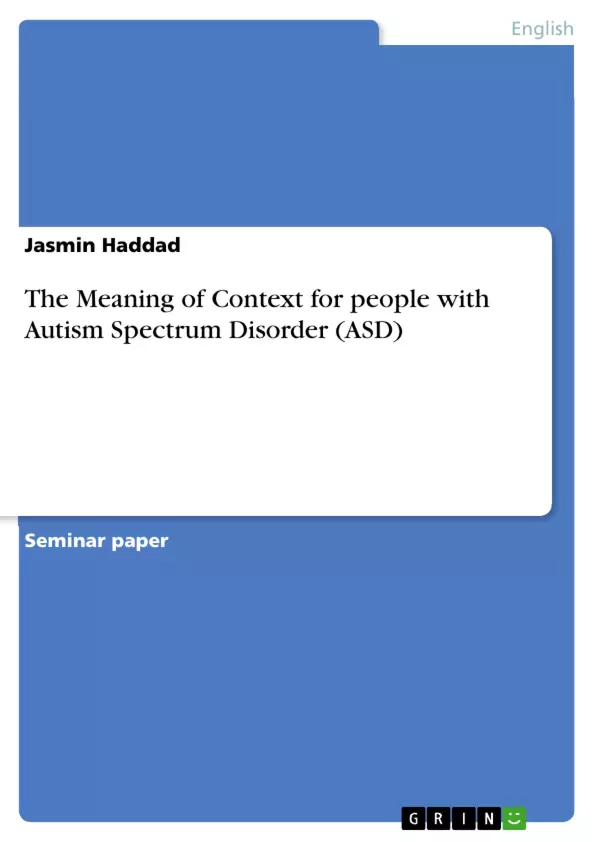This paper examines the meaning of context for people with Autism Spectrum Disorder (ASD) by utilizing and transferring the meaning of context in Grice’s cooperative principle and Sperber and Wilsons Relevance Theory. To get into the topic, the common understanding of the term “context”, the variety in which this term can be used and its typical function in linguistics will be observed in the first chapter. The main part of this paper will be concerned with Autism Spectrum Disorder.
In order to investigate the meaning of context for affected people, the diagnostic symptoms and associated communication disorders have to be analyzed at first. Afterwards, these impairments will be applied to Grice’s cooperative principle and Sperber and Wilsons Relevance theory, which both provide a framework for getting to the bottom of the meaning of context for people with ASD. Afterwards, empirical data, in the form of interview transcripts, will be used to substantiate the previous discoveries. A summary of all findings and their connections will be provided in the conclusion.
Inhaltsverzeichnis (Table of Contents)
- Introduction
- Context
- Autism Spectrum Disorder
- Social Communication Disorder
- Worldmaking
- Pragmatic Impairments
- Conversational Implicature and Grice's Cooperative Principle
- Relevance Theory
- Case Studies
- Conclusion
Zielsetzung und Themenschwerpunkte (Objectives and Key Themes)
This paper aims to explore the meaning of context for individuals with Autism Spectrum Disorder (ASD), utilizing Grice's cooperative principle and Sperber and Wilson's Relevance Theory. It examines how context, often taken for granted in typical communication, becomes a complex issue for individuals with ASD.
- The multifaceted nature of context and its importance in understanding human actions and making sense of the world.
- The challenges faced by individuals with ASD in understanding and using context in communication and social interaction.
- The application of Grice's cooperative principle and Relevance Theory to analyze communication impairments in ASD.
- The role of pragmatic impairments and language comprehension in defining ASD.
- Empirical data analysis using interview transcripts to support theoretical findings.
Zusammenfassung der Kapitel (Chapter Summaries)
- Introduction: This chapter establishes the central premise that context plays a crucial role in understanding reality and human interactions. It highlights the difficulties individuals with ASD face in comprehending and utilizing context, setting the stage for the investigation of this issue.
- Context: The chapter delves into the definition and various dimensions of context, exploring its significance in linguistics and cognitive science. It differentiates between external and internal context, shedding light on how individuals perceive and utilize context in everyday interactions.
- Autism Spectrum Disorder: This chapter provides an overview of ASD as a neurodevelopmental disorder, outlining its key characteristics and diagnostic criteria. It emphasizes the heterogeneity of the disorder and highlights pragmatic impairments and language comprehension as common and defining features.
Schlüsselwörter (Keywords)
This paper focuses on the core concepts of context, Autism Spectrum Disorder (ASD), pragmatic impairments, language comprehension, Grice's cooperative principle, Relevance Theory, and empirical data analysis. It explores the interplay between these elements to understand how context influences communication and social interaction in individuals with ASD.
- Arbeit zitieren
- Jasmin Haddad (Autor:in), 2020, The Meaning of Context for people with Autism Spectrum Disorder (ASD), München, GRIN Verlag, https://www.grin.com/document/976076



